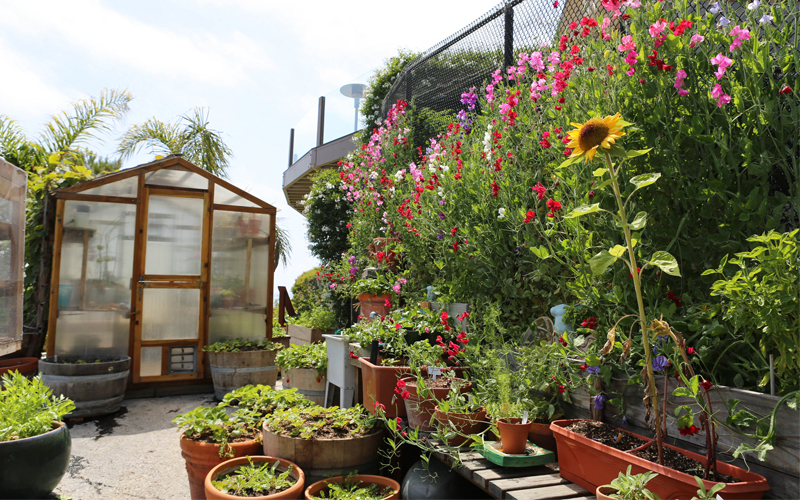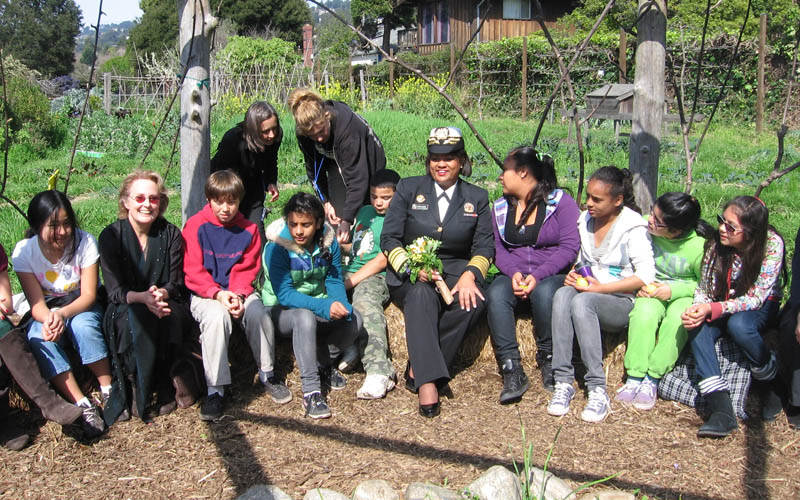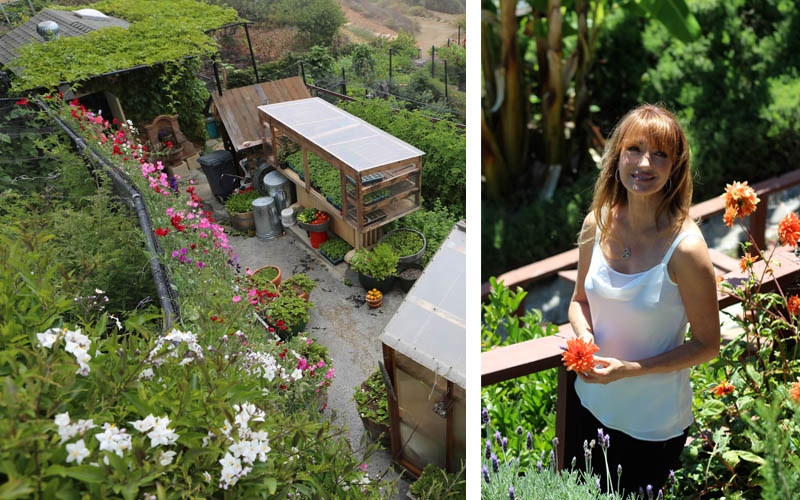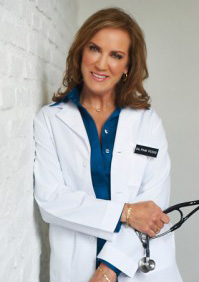
Photo provided by Jane Seymour of her own organic garden.
by guest blogger Pam Peeke, MD, MPH, FACP, best-selling author and expert on health, fitness, and nutrition
As senior science advisor to Elements Behavioral Health, the largest national residential addiction-treatment program, I’m in the process of integrating a natural, whole-foods-based nutrition program to support lifelong recovery. Presently, I’m also working with Malibu Vista, a women’s mental health treatment center, associated with the renowned Promises. There, we are developing our own sustainable organic garden so that everyone can benefit from freshly picked herbs and vegetables. It’s not just the chefs who are enjoying the digging and seeding. The clients have found that by becoming intimate with the earth, their healing process is greatly improved. What a win-win-win. Your mind, body, and soul form a powerful healing triad.
As a University of California–Berkeley alumna, I had the pleasure of introducing my friend and colleague, U. S. Surgeon General Regina Benjamin, MD, to a truly extraordinary woman, Alice Waters. Many know Alice as the founder of the famous organic food–based Berkeley restaurant Chez Panisse. While at Berkeley, I was one of the first patrons enjoying her unique cuisine. However, what are most amazing are the organic gardens from which Waters draws her herbs and vegetables.
She began the gardens at Berkeley’s Martin Luther King, Jr. Middle School and literally created an edible schoolyard, tended by the students who then reap the reward of their gardening with every kind of natural, appetizing delight. When I brought Dr. Benjamin to the school, it was the first time in history that a sitting Surgeon General had seen the gardens. The children were beside themselves. One young boy presented Dr. Benjamin with a zucchini he’d grown himself. Cautiously handing her his prize vegetable, he said, “Please be careful with this. It took me a while to make it happen!” Smiling, Dr. Benjamin gladly accepted his gift, and, winking, said she was going to take very good care of his zucchini. I’ll never forget that moment.

Alice Waters and U. S. Surgeon General Regina Benjamin in the Edible Schoolyard with Martin Luther King, Jr. Middle School students.
I was thinking about all this when my good friend, Emmy-award-winning actress Jane Seymour recently invited me to drive down the road to her Malibu home and see the organic garden she’s talked about so often. Earlier this year, I had the absolute pleasure of taping a terrific nutrition segment for Jane’s new PBS show, Feel Grand, talking about the value of organic produce.
When Jane invited me over, I’d conjured a vision of a lovely beach home with a small patch of plants. I was completely shocked to discover a huge hill completely covered with row upon row of every conceivable vegetable and fruit. A labor of love that began 20 years ago, Jane’s green dream-come-true is breathtaking. Hiking through orchards of guava trees overloaded with fruit, banana trees towering over rows of kale, blackberry vines, vibrant, colorful flowers, and endless lavender bushes, I felt inclined to start plucking everything I could grab, and get ready for dinner, which, of course, was an organic feast. 63 years young, Jane glows like the plants with which she nourishes her mind and body.

Jane Seymour and her organic garden. Photos provided by Jane.
Inspired by our time together, I was thinking about people everywhere who want to grow their own garden but may not know how to start. Happily, Maria Rodale and her team have had your back with the company’s outstanding magazine Organic Gardening, which was launched in 1942. I savor every single page and cannot wait to literally dig into my own gardens with new inspirations. But wait, there’s more: Rodale has recently announced that in April 2015, Organic Gardening will transform into Organic Life, a new “handbook for living naturally in the modern world.” I love this comprehensive approach to natural living, honoring “the belief that we all have the potential to learn more about ourselves and about fresh ways to engage—spiritually, physically, emotionally, intellectually—with our environment and our communities.”
Meanwhile, if you’re an aspiring organic gardener and want to grown your own, there are some easy, accessible things that you can do to get started on a green path to health and wellness. If you want a comprehensive description of the A-to-Z guide for organic gardening, there’s none better than Organic Gardening’s beginner’s guide.
Here’s a sneak peek.
- Plan your plot. You’ll want dry soil that doesn’t clump. Loosen up the dirt down to 12 inches, add a half-inch layer of compost, and then for the next three weeks, let the soil settle down as you rake and pull any weeds that may poke their heads through your newly minted organic garden. The compost is important because it provides the plants with slow-release nourishment for the seeds, while also supporting beneficial microbes in the soil.
- Dig in. Here’s where you can express yourself in any way you want. Some folks love to be super-organized and plant in rows. Others like to let it rip, planting with no particular blueprint. The plants don’t care, so it’s all up to you. Any way you go, you’ll have to dig shallow holes for the seeds.
- Hydrate with care. You don’t want to overdo it with water. Moistening, not soaking, the soil is key. And here’s a nifty tip. Water before, not after, seeding to protect the seeds from being displaced and washed away.
- Sow your seeds. Read the seed packet carefully to know how far apart to plant the seeds. Even if they come up too closely, you’ll just thin the plants and eat the ones you’ve pulled! Usually, you’ll either plant two to three seeds per hole or spread the bunch in a trench row (if that’s how you organized your plot).
- Close their dirt home. Again, make certain to read that seed packet to know whether or not your plant needs some light to germinate. Those that do require light need very little dirt coverage. For all others, all you have to do is lightly bury the seeds and scatter dirt over them to make sure they’ve got good contact with the dirt.
- Water the sprouts. You need to keep an eye out to make sure the dirt doesn’t get too dry. Just keep the area moist as the seeds sprout.
There’s nothing more fulfilling than completing the circle of life by planting, harvesting, and enjoying, whether it’s herbs, vegetables, fruits, or even flowers. It’s time to dig in and grow your own.
 Pamela Peeke, MD, MPH, FACP, is a Pew Scholar in nutrition and metabolism, assistant professor of medicine at the University of Maryland, and a fellow of the American College of Physicians. A triathlete and mountaineer, she is known as “the doc who walks the talk,” living what she’s learned as an expert in health, fitness, and nutrition. Her current research at the University of Maryland centers on the connection between meditation and overeating. She is the author of many best-selling books, including Fight Fat after Forty. Her newest book is the New York Times bestseller The Hunger Fix.
Pamela Peeke, MD, MPH, FACP, is a Pew Scholar in nutrition and metabolism, assistant professor of medicine at the University of Maryland, and a fellow of the American College of Physicians. A triathlete and mountaineer, she is known as “the doc who walks the talk,” living what she’s learned as an expert in health, fitness, and nutrition. Her current research at the University of Maryland centers on the connection between meditation and overeating. She is the author of many best-selling books, including Fight Fat after Forty. Her newest book is the New York Times bestseller The Hunger Fix.




It always makes me happy to see organic gardens, and this one is so lovely. Thanks for the heart-warmer on this cold day!!